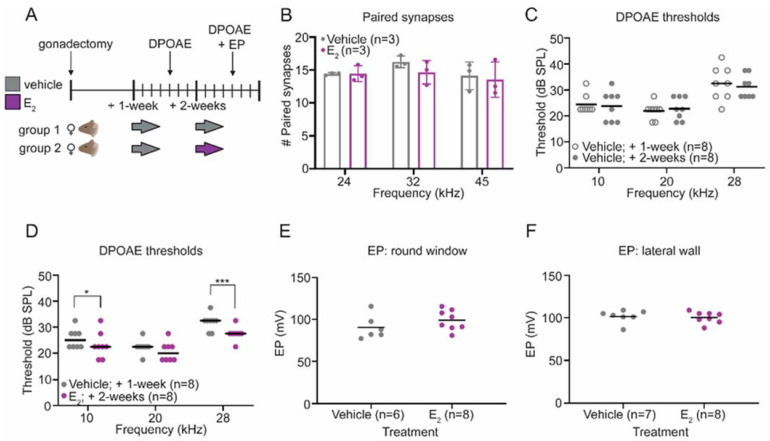Figure 2.
E2-replacement in gonadectomized female mice improves distortion product otoacoustic emission (DPOAE) thresholds but does not alter the number of paired inner hair cell (IHC) synapses or the endocochlear potential. (A) Schematic of the experimental design. Both cohorts of mice received 3 daily subcutaneous injections of vehicle 1-week post-gonadectomy. Two-weeks post-gonadectomy, one cohort received 3 daily subcutaneous injections of vehicle, while the other cohort received 3 daily subcutaneous injections of E2 (300 µg/kg). (B) Histological analysis of cochlear tissue collected from vehicle-treated and E2-treated mice demonstrated no differences in the number of paired IHC-auditory nerve fiber (ANF) synapses. (C) Analysis of DPOAE thresholds in the cohort treated with vehicle during both weeks of data collection revealed no changes. (D) Following E2-replacement, gonadectomized female mice displayed improved DPOAE thresholds at 10 kHz (p = 0.0216) and 28 kHz (p = 0.0001). (E,F) The endocochlear potential measured via a round window approach (E) and via a lateral wall approach (F) is not changed by E2-replacement. DPOAE thresholds were compared within groups using a RM 2-way ANOVA followed by Sidak’s multiple comparison test. Paired synapses were compared using a 2-way ANOVA followed by Sidak’s multiple comparisons test. Endocochlear potentials were compared using a student’s t-test. n = number of mice; Paired synapses: mean ± SD; DPOAE thresholds and EP measurements: bars display the mean; * p < 0.05, *** p < 0.001.

